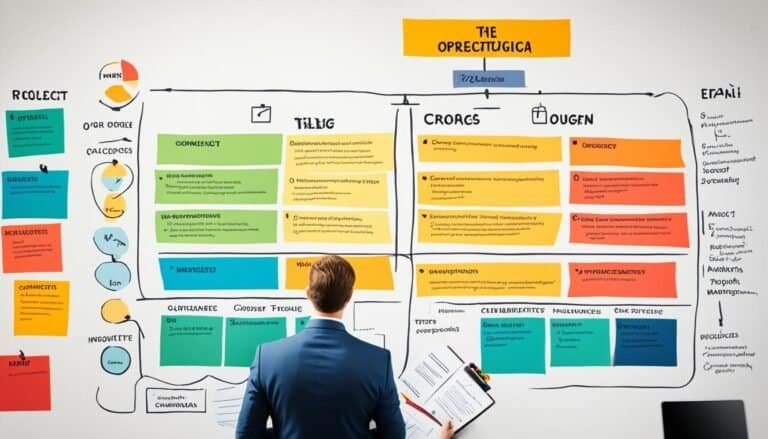Creating a Communication Plan for Effective Project Management
Effective project management relies heavily on clear and efficient communication. Without a well-defined communication plan, projects can easily veer off track, leading to delays, misunderstandings, and ultimately, failure.
In today's fast-paced and interconnected business world, creating a communication plan is essential for project success. By establishing clear channels of communication, defining roles and responsibilities, and implementing strategies for effective communication, project managers can ensure that the right information reaches the right people at the right time.
But how exactly does one go about creating a communication plan that truly enhances project management? In this discussion, we will explore the key components of a communication plan and delve into the strategies for monitoring and adjusting it to ensure optimal project outcomes.
So, let's dive into the world of effective communication in project management and discover how it can be the key to achieving project success.
Key Takeaways
- Clear communication is crucial for successful outcomes in project management and stakeholder engagement.
- Tailoring communication strategies to meet the specific needs of each stakeholder is essential.
- Well-defined roles and responsibilities ensure efficient project management.
- Regularly monitoring and adapting the communication plan is necessary for its effectiveness.
Importance of Communication in Project Management
Effective communication is crucial in project management as it ensures clear understanding, collaboration, and successful project outcomes. Communication acts as the backbone of any project, allowing team members to stay aligned, share information, and make informed decisions.
One of the key reasons communication is important in project management is its direct impact on project success. Effective communication ensures that everyone involved in the project understands the goals, objectives, and expectations. It helps in clarifying doubts, resolving conflicts, and addressing any challenges that may arise during the project lifecycle.
Clear and consistent communication promotes collaboration among team members, fostering a sense of unity and shared responsibility. It enables effective decision-making, as team members can exchange ideas, share insights, and provide valuable feedback.
Furthermore, communication plays a vital role in managing stakeholders. Regular updates and transparent communication build trust and credibility, ensuring that stakeholders remain engaged and supportive throughout the project.
Key Components of a Communication Plan
A well-designed communication plan is essential for effective project management. It serves as a guide for how information will be shared, who will be responsible for communication tasks, and what channels will be used.
Below are three key components that should be included in a communication plan:
- Communication strategy: This outlines the overall approach to communication for the project. It includes defining the project's objectives, target audience, and key messages. The strategy should also consider the timing and frequency of communication activities, ensuring that relevant information is shared in a timely manner.
- Communication guidelines: These are the specific rules and guidelines that govern how communication should be conducted within the project. This includes guidelines for written and verbal communication, as well as guidelines for communication through various channels, such as email, meetings, and project management tools. Clear guidelines help ensure consistency and clarity in communication.
- Stakeholder engagement plan: A stakeholder engagement plan identifies the project's key stakeholders and outlines how they will be engaged throughout the project lifecycle. This includes identifying their communication needs and preferences, as well as determining the best methods for engaging with them. Engaging stakeholders early and consistently can help build trust and ensure their buy-in to the project.
Establishing Clear Communication Channels
To ensure seamless communication within a project, it is crucial to establish clear channels through which information can be effectively shared and received. Communication tools play a vital role in facilitating effective collaboration among team members. These tools enable real-time communication, document sharing, and task management, ensuring that everyone is on the same page.
One commonly used communication tool is email. It allows for formal communication, providing a record of conversations and decisions made. However, it may not be the most efficient tool for quick exchanges or urgent matters.
Instant messaging platforms, such as Slack or Microsoft Teams, provide a more dynamic and immediate form of communication. Team members can collaborate in real-time, share files, and hold video conferences. This enhances productivity and fosters a sense of teamwork.
Project management software, such as Trello or Asana, can also serve as communication tools. These platforms allow for task assignment, progress tracking, and document sharing. Team members can easily update their progress and communicate any challenges they face.
Defining Roles and Responsibilities
In order to ensure clear communication and efficient project management, it is essential to establish well-defined roles and responsibilities for each team member. By clarifying expectations and assigning tasks, the project can run smoothly and effectively.
Here are three key considerations when defining roles and responsibilities:
- Clearly define each team member's role: Start by identifying the specific skills, expertise, and responsibilities required for the project. Assign roles based on individual strengths and ensure that each team member understands their role and how it contributes to the overall project goals.
- Set clear expectations: Clearly communicate the project's objectives, milestones, and deadlines to each team member. Make sure everyone understands what is expected of them and the quality of work that is required. Regularly revisit and reinforce these expectations to keep everyone aligned and accountable.
- Assign tasks and responsibilities: Break down the project into smaller tasks and assign them to specific team members. Consider each person's abilities, workload, and availability when distributing tasks. Clearly communicate deadlines and dependencies to ensure that everyone is aware of their responsibilities and can work together effectively.
Strategies for Effective Communication
Establishing effective communication strategies is crucial for ensuring seamless project management, building upon the foundation of well-defined roles and responsibilities. Clear and efficient communication is the cornerstone of successful project delivery, as it facilitates collaboration, minimizes misunderstandings, and keeps all stakeholders informed and engaged throughout the project lifecycle.
To implement effective communication strategies, project managers should consider the following key elements:
- Communication Channels: Determine the most suitable channels for communication based on the project's requirements and the team's preferences. This could include regular team meetings, email updates, project management tools, or instant messaging platforms.
- Frequency and Timing: Establish a communication schedule to ensure that all team members receive timely updates and have the opportunity to ask questions or seek clarification. This schedule should include regular progress reports, milestone updates, and ad-hoc communication as needed.
- Tailored Messages: Adapt communication styles and messages to suit different stakeholders' needs and preferences. This could involve adjusting the level of detail, using appropriate language, and delivering information in a format that is easily understandable and accessible.
Monitoring and Adjusting the Communication Plan
The effective monitoring and adjustment of the communication plan is essential for maintaining clear and efficient communication throughout the project lifecycle. By tracking progress and soliciting feedback, project managers can identify any gaps or issues in the communication plan and make necessary adjustments to ensure effective communication.
To monitor and adjust the communication plan, project managers can:
- Regularly review the communication plan: Project managers should regularly review the communication plan to ensure it aligns with project goals and objectives. This includes assessing if the chosen communication channels are effective and if the frequency of communication is sufficient.
- Seek feedback from stakeholders: Project managers should actively seek feedback from stakeholders to understand their communication needs and preferences. This can be done through surveys, interviews, or informal discussions. By incorporating stakeholder feedback into the communication plan, project managers can tailor their communication strategies to meet the specific needs of each stakeholder.
- Establish a feedback loop: Project managers should establish a feedback loop where stakeholders can provide ongoing input and suggestions for improving communication. This can be done through regular check-ins, feedback meetings, or an online platform. By creating an open and transparent feedback loop, project managers can continuously improve the communication plan based on real-time feedback from stakeholders.
Conclusion
In conclusion, effective communication is crucial for successful project management.
By implementing a well-defined communication plan, project teams can ensure clear and efficient information exchange.
This includes establishing clear communication channels, defining roles and responsibilities, and utilizing strategies for effective communication.
Regular monitoring and adjustments to the communication plan are also essential for maintaining an open and transparent flow of information.
By prioritizing communication, projects can overcome challenges and achieve their objectives with remarkable ease and efficiency.







